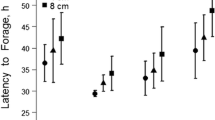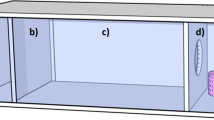Abstract
Drosophila melanogasteradults were employed in single resource patches of varying density and size and in a multiple-patch array to determine the degree to which resource dispersion influences searching success. Individuals from rover and sitter selected lines, with extreme genotypes for local search duration, are not as successful as control-line (wild-type) flies in locating sucrose drops in single patches varying in size and density. The number of new drops located differed significantly between fly lines in all patch types, except in a high-density patch, and within each fly line over the different patch sizes and densities. The similarities in number of drops found by rovers and sitters in all patch types are not reflected in the time periods spent searching. In the multiple-patch array sitters never left the central patch, whereas most rovers and con-trol-line flies found additional patches. The proximate explanations for the success or failure of the three fly lines in different patch sizes and densities relate to the looping locomotor pattern characterizing local search in D. melanogaster.The reactivation of searching each time a drop is ingested or revisited keeps an individual in the immediate vicinity of the last encountered resource. Flies from the selected lines, each exhibiting extreme types of locomotor patterns, leave patches relatively unexploited because local search consists either of rapid, nearly linear movement away from a drop in rovers or of relatively long bouts of local search in sitters, which promotes revisiting rather than locating new drops. Control-line flies locate more drops than either rovers or sitters and in less time than sitters, suggesting that their intermediate phenotype for search behavior allows for more flexibility in searching in various patch sizes and resource densities. The results are discussed with reference to environmental and physiological factors that may modify searching behavior and, possibly, enhance the survival of individuals with extreme genotypes.
Similar content being viewed by others
References
Bell, W. J. (1985). Sources of information controlling motor patterns in arthropod local search orientation.J. Insect Physiol. 31: 837–847.
Bell, W. J., and Nagle, K. (1987). Pattern of inheritance of adult rover/sitter traits.Dros. Info. Serv. (in press).
Bell, W. J., and Tortorici, C. (1987). Genetic and nongenetic control of search duration in adults of two morphs onDrosophila melanogaster.J. Insect Physiol. 33: 51–54.
Bell, W. J., Tortorici, C., Roggero, R. J., Kipp, L. R., and Tobin, T. R. (1985). Sucrose-stimulated searching behavior inDrosophila melanogaster in a uniform habitat: Modulation by period of deprivation.Anim. Behav. 33: 436–448.
Beukema, J. J. (1968). Predation by the three-spined stickleback(Gasterosteus aculeatus L.).Behaviour 31: 1–126.
Cain, M. L. (1985). Random search by herbivorous insects: A simulation model.Ecology 66: 876–888.
Cain, M. L., Eccleston, J., and Kareiva, P. M. (1985). The influence of food dispersion on caterpillar searching success.Ecol. Entomol. 10: 1–7.
Carter, M. C., and Dixon, A. F. G. (1982). Habitat quality and the foraging behaviour of coccinellid larvae.J. Anim. Ecol. 51: 865–878.
Daniel, W. E. (1978).Applied Nonparasitic Statistics, Houghton Mifflin, Boston.
Dethier, V. G. (1957). Communication by insects: Physiology of dancing.Science 125: 331–336.
Dethier, V. G. (1976).The Hungry Fly, Harvard University Press, Cambridge, Mass.
Downes, W. L., and Dahlem, G. A. (1987). The role of Homoptera in the evolution of Diptera.Environ. Entomol. 16: 847–854.
Dunn, O. J. (1964). Multiple comparisons using rank sums.Technometrics 6: 241–252.
Evans, H. F. (1976). The searching behavior ofAnthocoris confusus (Reuter) in relation to prey density and plant surface topography.Ecol. Entomol. 1: 163–169.
Fromm, J. E., and Bell, W. J. (1987). Search orientation ofMusca domestica in patches of sucrose drops.Physiol. Entomol. 12: 297–307.
Harris, M. O., and Miller, J. R. (1984). Foliar form influences ovipositional behaviour of the onion fly.Physiol. Entomol. 9: 145–155.
Jones, R. E. (1977). Search behaviour: A study of three caterpillar species.Behaviour 60: 237–259.
Kareiva, P. (1983). Influence of vegetation texture on herbivore populations: Resource concentration and herbivore movement. In Denno, R., and McClure, M. (eds.),Variable Plants and Herbivores in Natural and Managed Systems, Academic Press, New York, pp. 259–289.
Murdie, G., and Hassell, M. P. (1973). Food distribution, searching success and predator-prey models. In Bartlett, M. S., and Hiorns, R. W. (eds.),The Mathematical Theory of the Dynamics of Biological Populations, Academic Press, New York, pp. 87–101.
Nagle, K., and Bell, W. J. (1987). Genetic control of the search tactic of adultDrosophila melanogaster: An ethometric analysis of rover/sitter traits.Behav. Genet. 17: 385–408.
Pyke, G. H. (1984). Optimal foraging theory: A critical review.Annu. Rev. Ecol. Syst. 15: 523–575.
Smith, J. N. M. (1974). The food searching behavior of two European thrushes. II. The adaptiveness of the search patterns.Behaviour 49: 1–61.
Sokolowski, M. B. (1980). Foraging strategies ofDrosophila melanogaster: A chromosomal analysis.Behav. Genet. 10: 291–302.
Sokolowski, M. B. (1985). Genetics and ecologyof Drosophila melanogaster larval foraging and pupation behavior.J. Insect Physiol. 31: 857–864.
Stanton, M. L. (1983). Spatial patterns in the plant community and their effects upon insect search. In Ahmad, S. (ed.),Herbivorous Insects: Host-Seeking Behavior and Mechanisms, Academic Press, New York, pp. 125–157.
Waage, J. K. (1979). Foraging for patchily-distributed hosts by the parasitoid,Nemeritis canescens.J. Anim. Ecol. 48: 353–371.
Author information
Authors and Affiliations
Rights and permissions
About this article
Cite this article
Tortorici, C., Bell, W.J. Search orientation in adultDrosophila melanogaster: Responses of rovers and sitters to resource dispersion in a food patch. J Insect Behav 1, 209–223 (1988). https://doi.org/10.1007/BF01052239
Accepted:
Issue Date:
DOI: https://doi.org/10.1007/BF01052239




